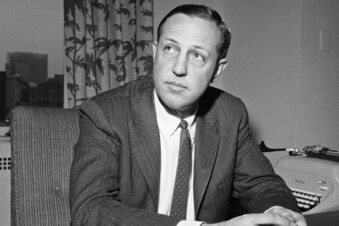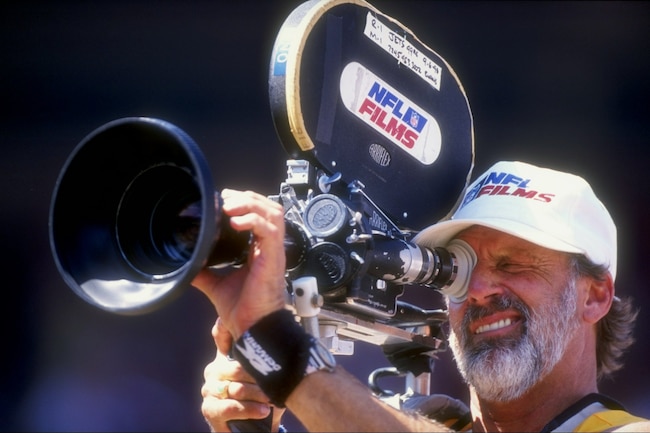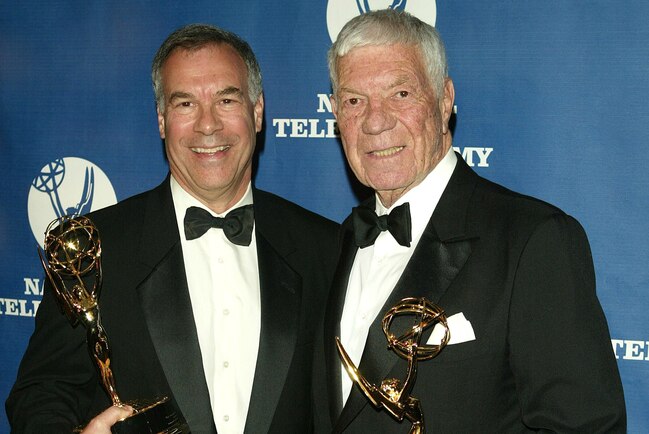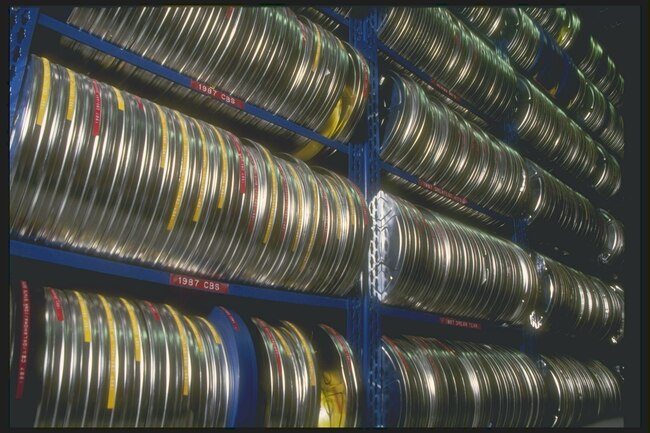MORE COWBELL:
Visionary Artistry of Ed Sabol's NFL Films Remains Unrivaled and Irresistible
By Mike Tanier ,

AP Images
There is no such thing as MLB Films. Baseball history is therefore grainy and fuzzy, choppily edited from old newsreels and videotape. Footage from even 25 years ago looks like blurry backyard photography from a bygone era.
Therefore, we have hundreds of hours of full-color, brilliantly-edited, meticulously preserved testaments to the beauty of professional football and the glory of its superstars during the NFL's rise to prominence in the 1960s and 1970s.
Thanks to NFL Films, professional football history doesn't collect dust in an encyclopedia or decay into columns of statistics. NFL Films has spent over five decades making ordinary games look legendary, and making legendary games feel and look fresh and vivid to new generations.
NFL Films exists because Ed Sabol willed it into existence. Sabol, who died Monday evening at age 98, decided in the early 1960s that he would rather be a filmmaker than an overcoat salesman.
He left the haberdashery business and audaciously bid $3,000 for the right to film the 1962 NFL Championship Game. That was double the second-highest bid. In the days before cable television, when sports highlight films were shown at local Rotary Club mixers to drum up season-ticket sales, the rights to film the precursor to the Super Bowl weren't worth much. Sabol got the job.
Sabol had an on-paper company named Blair Motion Pictures (after his daughter) and a clever 20-year-old moviemaking son named Steve. The Sabols produced an impressive championship film with slow-motion replays, unusual close-ups and a musical score. Most highlight reels of the time were just chopped-together collections of plays from wide angles. Sabol's vision matched the aspirations of NFL Commissioner Pete Rozelle, who was always on the prowl for ways to cast the NFL as a prestigious Cadillac of a sports league.

Anthony Camerano/Associated Press
Rozelle convinced NFL owners to give the Sabols seed money. Ed and Steve, meanwhile, set about learning how to actually make films.
"I had the imagination to write and produce movies, but I had to hire people with technical know-how and learn about filming, editing, and sound," Steve (who passed away in 2012) later told Inc.com. "It took me three years to figure out the NFL Films style, and [my father's] personality provided a protective shell while we experimented with the vision in my head."
NFL Films grew into a six-man operation and eventually produced a featurette titled They Call it Pro Football. The NFL Films website humbly proclaims it "the Citizen Kane of sports films," (with the help of an unattributed quote). They Call it Pro Football launched thousands of highlight reels, montages, documentaries and weekly half-hour programs. It redefined how American sports fans perceived professional football.
The film quality and cinematography was far more sophisticated than anything captured by the swiveling television cameras of the era. The editing purposely imitated Akira Kurosawa, a groundbreaking Japanese filmmaker only hardcore U.S. cinephiles would have recognized in the 1960s. The soundtracks, by composers like Sam Spence, became their own musical subgenre. John Facenda's narration recalled oratories from Shakespeare or classical-era histories. If the results weren't so consistently thrilling and entertaining, the sheer grandiosity of the films would have looked ridiculous.

Otto Greule Jr/Getty Images
You probably know a great deal about NFL Films: Facenda, Spence's rum-tum mash-ups of Bizet and disco and the way the Sabols rewrote the visual dictionary of how sports highlights were spliced together and served to the viewing public.
You might even know that those half-hour NFL Films features not only influenced the first generation of ESPN producers/editors (not to mention Chris Berman, who aped Facenda often during the freewheeling monologues that came to define modern sportscasting) but kept that fledging network on life support in the early 1980s. Blocs of NFL Films features spackled the network schedule with viable programming between volleyball games and Australian footie matches.
NFL Films helped give birth to the modern 24/7/365 sports news cycle by teaching the world how to package and mythologize sports during the lulls between the live games themselves.
But you probably don't know how much resistance Ed and Steve Sabol encountered from owners in those early years.
"In the beginning, the owners didn't like what we were doing," Steve Sabol said in the 2006 Inc.com interview. "They didn't like John Facenda as narrator; they wanted Curt Gowdy. They didn't understand we needed someone to read our scripts with gravitas and that it wasn't just off-the-cuff commentary."

Peter Kramer/Getty Images
That sounds crazy now, but the Sabols were the crazy ones in the 1960s, drawing inspiration from international cinema, opera and the fine arts to tell stories about a silly game. Baseball, basketball and hockey leagues didn't feel the need to create epic, elegiac art films about their games. They still don't.
When it comes to history, it's their loss. Gale Sayers and Dick Butkus are now just a YouTube click away, with ample footage from 50 years ago that's so clear it could have been recorded last Sunday—their grace and brutality vibrant and alive for a new generation of fans to discover.
Contemporaries like Russell, Howe or even Willie Mays are practically hieroglyphs in comparison.
Take five minutes to watch some clips from They Call it Pro Football. Don't worry much about the football itself. Soak in the atmosphere: coaches in suits, fans in fedoras, cheerleaders with feathers in their hair, announcers with cigarettes in their hands. Listen to the lingo. Note the hairstyles and the cars outside the stadium.
NFL Films documented American popular cultural history as much as it documented football history. The Sabols' creative vision yielded something timeless and seamless. We witness our grandparents, wearing unfamiliar clothes from a forgotten past, participating in an event which we instantly recognize. It's almost like we can still walk into the Cotton Bowl to watch a Cowboys game, or cheer for Johnny Unitas from the stands in our sports coats and ties.
That's what Ed Sabol gave us: not just the language of our sports present, but a tangible, visible tether to our sports past.
Those first tidbits from Sabol's early years at NFL Films still get repurposed as prime-time television entertainment. NFL Network, another television venture built on the back of the Sabol family's vision, has produced the successful NFL's Top Ten program for many years. The concept is as 21st-century as can be: a countdown as the hook for a series of short, digestible mini-productions. Heck, that's part of the foundation Bleacher Report was built upon.
But the programs themselves are pure products of the Sabol vision. NFL's Top Ten is made possible by a library of pristine Joe Namath, Franco Harris and Joe Montana film footage, and by a long legacy of using those film clips to create both a fun television program and football mythology.
I have had the pleasure of being one of the NFL's Top Ten talking heads for five seasons, my own little observations and zingers becoming a tiny part of that 50-plus year filmmaking tapestry. A few times per year, I drive to NFL Films studios in southern New Jersey for a few hours of filming. I had the pleasure of visiting Steve Sabol's office before he died, and I toured a complex teeming with memorabilia and art that spans football history from the Great Depression to the present.

Scott Halleran/Getty Images
Two things greet anyone who walks through the doors of NFL Films headquarters. The first is a wall of Emmys that would put any other television producer on Earth to shame. The second is an enormous film vault, sealed off behind glass to protect its contents from the elements. It's an archive of six decades of Super Bowls, playoff games, ordinary games, bloopers, mic'd up coaches and players, interviews, and footage of fans, stadiums, cheerleaders and tailgaters of a bygone era.
The Emmy awards are spectacular. But the archive is a national treasure, a repository of collective memory, a library of beautifully preserved sights and sounds that no sport—and perhaps no other endeavor before the digital age—can hope to match.
That archive is the treasure Ed Sabol bequeathed to us. May we cherish the history he made possible for us to remember.
Mike Tanier covers the NFL for Bleacher Report. Some biographical and historical information from "America's Game," by Michael MacCambridge.
